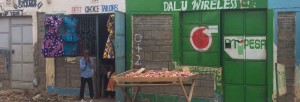
“It’s a total of KSh 270 ($2.7 USD) for the ride, thank you.” the taxi driver said.
My friend hands over a Ksh 1,000 note for the ride, yet our taxi driver shakes his head to say that he has no change for us.
“That’s okay, we can M-pesa!” my friend responded as both him and the driver pulles out their phone at the same time to settle the unfinished bill.
M-Pesa, a money transfer system using mobile devices, has made a revolutionary change to the banking scene of the entire Kenya. “M” stands for “mobile” whilst “pesa” refers to “money” in Swahili. M-pesa was initially launched in 2007 by Safaricom, the largest mobile network operator in Kenya, has enabled both formal and informal Kenyans in making cashless transactions. Currently, any Kenyans will tell you to get a Safaricom phoneline in order to make use of the M-pesa service when you arrive in the country. Today, 20 million customers in Kenya are registered for this branchless banking service.
“I never carry even my wallet anymore,” declares my colleague as he takes out his cell phone to pay for his lunch bill at a local joint. Myyoung Kenyan colleague pays his electric bill, cable TV, rent, online purchases and supermarket shopping via M-pesa. With access to any mobile device (not even internet!), M-pesa allows the farmers working in a rural village in making a payment to his friend across the country without travelling long-distance to deliver the cash.
The M-pesa service allows users to deposit money into an account stored on their cell phones via a network of agents, to send balances using PIN-secured SMS text messages to other users, including sellers of goods and services, and to redeem deposits for regular money. Users are of course charged a small fee for making financial transaction using the service.
“It is no exaggeration to say that Kenya’s economy depends on M-Pesa” states a Credit Suisse article. According to the Central Bank of Kenya, the value of all transactions in the past year represented more than 40% of the country’s GDP. Furthermore, M-pesa has the advantage of transparency. M-pesa payment records are maintained online and available for retrieval by the parties to a transaction – eliminating the once widespread problem of cash transactions disappearing on the way to their intended recipients (e.g. “putting one’s hands in the till”).
Yet, any transactional system will have its drawbacks. Money held in M-pesa account are not interest bearing and the system also experience occasional break-down. Moreover, like any other banking system, the occurrence of fraud is unavoidable. However, it is difficult to deny the credit of M-pesa – bringing a leap in the Kenyan banking scenery into the digital age of tomorrow.